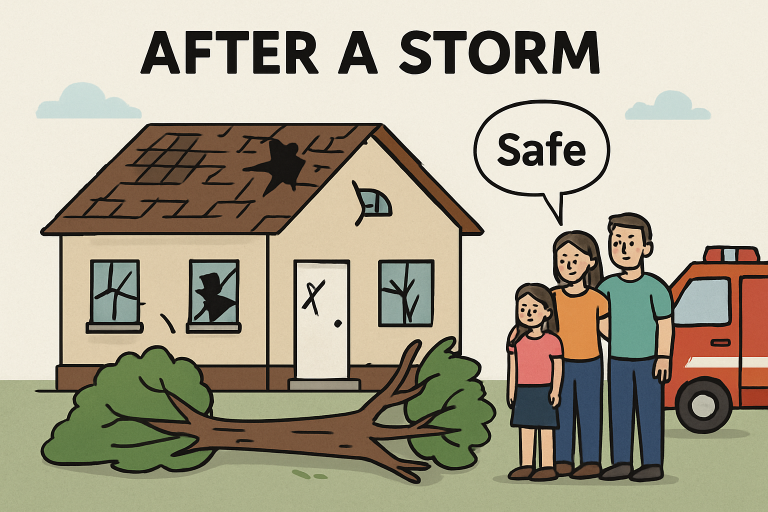When a severe storm strikes, the aftermath can leave homeowners and property managers overwhelmed and uncertain about what action to take. From downed trees and power outages to flooded basements and destroyed roofs, the disruption can be both physically and emotionally draining. In these moments, taking well-informed, practical steps is crucial to ensuring a rapid recovery and a safe and successful one.
Every decision you make in the first hours and days following the disaster will impact how quickly you can restore normalcy. For immediate emergencies and complex repairs, seeking storm damage restoration services ensures your property and health are protected, minimizing potential hazards and preventing additional losses that could spiral into costlier repairs.
Adopting a methodical, step-by-step approach is the best way to regain control in the chaotic aftermath of a storm. Following a proven protocol, you strengthen your ability to safeguard loved ones, preserve property, and protect long-term financial interests during one of the most stressful life events.
The comprehensive guide below outlines the critical phases of storm recovery, detailing what you need to do to restore your property and your peace of mind as you rebuild.
Ensure Safety First
Your safety—and the safety of your loved ones—should always come first after a storm. Even if the temptation to survey the damage is intense, approach your home or property cautiously.
Structures that have endured heavy winds, flooding, or falling debris may be severely weakened, appearing deceptively sturdy despite hidden dangers. Look for red flags such as large cracks in exterior walls, shifted or sinking foundations, out-of-place doors and windows, or sagging ceilings. Never enter a building that looks unstable until a professional has inspected it.
Be particularly vigilant for hidden hazards like downed power lines—these can electrify standing water or metal fences, causing potentially fatal injuries. Gas leaks are another threat; if you smell or suspect a leak, leave the area immediately and alert emergency services.
Floodwaters can harbor dangerous bacteria, sewage, sharp metals, and even wildlife, making them a significant health peril. Reliance on local emergency services and official announcements is critical at this stage. Follow advisories regarding curfews, road conditions, and evacuation orders.
Wait for authorities to issue an “all clear” before returning to your property—even if the weather has improved, hidden dangers can persist for hours or days. Your patience and prudence will help ensure the recovery process starts safely.
Document the Damage
Accurate and thorough documentation is essential after a storm, especially for insurance and legal purposes. Conduct a comprehensive property assessment once you’ve verified that it’s safe. Arm yourself with a camera, smartphone, or video device and systematically walk through every affected area.
Capture wide shots and close-ups of all damage, including physical harm to roofs, walls, windows, and foundations, as well as any interior flooding, ruined appliances, or broken furniture.
Don’t forget to photograph outdoor issues like toppled trees, damaged fences, and vehicles impacted by debris. Written notes can supplement visual evidence by providing a running inventory of impacted belongings and their estimated values. Organize receipts, warranty information, and identification for valuable or sentimental possessions. These records create a detailed, itemized account that can help you justify claims and avoid disputes during the insurance process.
Consistent, methodical record-keeping is your best protection—if there are questions or challenges during claim review, you’ll have the evidence you need to support your case.
Contact Your Insurance Provider
Once your documentation is ready, contact your insurance provider immediately. Time is of the essence, as many policies contain strict deadlines for reporting damages after weather-related events. Be prepared to provide the insurance company with copies of your evidence, including photos, receipts, and a detailed description of losses. Ask targeted questions about claim-filing procedures: How do you initiate a formal claim? What paperwork is needed? When will an adjuster visit to inspect your property?
Inquire about recommendations for reputable contractors or emergency repairs, and take advantage of any guidance on preventing further damage before the claim is settled. Above all, keep a written record of every interaction with your insurer, including dates, times, contact names, and specific instructions you’ve received.
Clear, proactive communication can reduce delays, so you move ahead with cleanup and repairs as efficiently as possible.
Begin Immediate Cleanup
Swift and strategic action is vital when initiating cleanup after a major storm. You aim to halt secondary damage from prolonged water exposure, open structures, and lingering debris. Start by safely removing standing water with pumps, wet/dry vacuums, or, in severe cases, the help of a professional extraction service.
The faster you can dry out affected areas, the less likely mold or structural damage will take hold. Relocate salvageable items like important documents, electronics, and furniture to dry places.
Check your local guidelines for debris disposal, as certain storm materials require special handling. Damaged drywall, carpeting, and insulation are fertile grounds for mold and should be removed promptly. Remember to wear gloves, masks, and other protective gear during cleanup, as post-storm conditions often introduce contaminants from sewage or chemicals.
Mold is a silent threat, capable of developing within 24 to 48 hours after water intrusion. If your space remains humid or damp, mold growth will accelerate and quickly become a health and structural hazard. Use fans and dehumidifiers to circulate air and remove excess moisture if safe. However, it’s safest to bring remediation experts who can handle hazardous materials with proper equipment for large-scale flooding or visible mold colonies.
Contaminated water—particularly that from river flooding, sewage backups, or sump pump failures—frequently contains infectious bacteria and chemicals, so always minimize direct contact. Professional storm damage restoration is invaluable in these conditions, offering expertise and peace of mind in eliminating hidden hazards.

Assess and Repair Structural Damage
Thorough and expert evaluation is a non-negotiable part of storm recovery regarding structural repairs. Storms can weaken a home’s foundation, frame, or roofing, causing problems that aren’t always visible. Licensed contractors, engineers, or certified restoration experts should inspect your property for dangerous conditions—think shifting foundations, sagging beams, or fractured supports.
If immediate action is needed, such as temporary roof tarping, board-ups, or structural supports, prioritize those repairs to halt further deterioration. Scheduling these repairs sooner protects your safety and can prevent minor damage from becoming extensive, costly issues.
Partnering with an experienced storm damage restoration service provides a cohesive, expert-led approach for every recovery step. A reputable team will oversee safety assessments, carry out critical repairs, and manage hazardous material removal. Their familiarity with insurance processes, local code requirements, and best practices expedites the return to pre-storm conditions.
By letting professionals coordinate the complex restoration logistics, you save valuable time, reduce emotional strain, and gain reassurance that every detail is handled with utmost care.
Plan for Long-Term Recovery
Proper recovery from a major storm extends beyond the initial cleanup and repairs. Use this event to build greater resilience into your home and lifestyle, reducing risks for future disruptions.
Consider investing in stronger, storm-resistant materials, reinforcing roofs, windows, and doors, or improving yard grading for better water drainage. If repeated flooding is a concern, evaluate landscape or drainage solutions designed to deflect water from your property. Developing an updated emergency plan with your family or business—complete with evacuation routes, communication protocols, and disaster kits—can make all the difference should disaster strike again.
Tapping into local rebuilding programs and community resources may provide financial assistance, emotional support, and expert advice during the often-lengthy journey back to normalcy. To ensure nothing is overlooked in your approach, consult the Hurricane Recovery Plan: 10 Tips for Business Owners for comprehensive guidance from industry professionals.
Community and Mental Health Resources
Emotional recovery is as important as physical and financial restoration after a severe storm. Experiencing loss, disruption, and uncertainty can have lasting mental health impacts. Don’t hesitate to connect with local support groups, family services, or counseling professionals to talk about your experience and access help if needed.
Sharing your challenges and progress with others affected in your community can foster a sense of togetherness and hope in adversity. Ultimately, storm recovery is not only about rebuilding your property—it’s also about reclaiming your sense of normalcy, safety, and peace.

